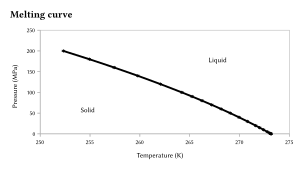Regelation
This article or section appears to contradict itself. (March 2024) |

Regelation is the phenomenon of ice melting under pressure and refreezing when the pressure is reduced. This can be demonstrated by looping a fine wire around a block of ice, with a heavy weight attached to it. The pressure exerted on the ice slowly melts it locally, permitting the wire to pass through the entire block. The wire's track will refill as soon as pressure is relieved, so the ice block will remain intact even after wire passes completely through. This experiment is possible for ice at −10 °C or cooler, and while essentially valid, the details of the process by which the wire passes through the ice are complex.
Regelation was discovered by
Surface melting


For a normal
The surface melting can account for the following:
- Low coefficient of frictionof ice, as experienced by skaters.
- Ease of compactionof ice
- High adhesion of ice surfaces
Examples of regelation
A glacier can exert a sufficient amount of pressure on its lower surface to lower the melting point of its ice. The melting of the ice at the glacier's base allows it to move from a higher elevation to a lower elevation. Liquid water may flow from the base of a glacier at lower elevations when the temperature of the air is above the freezing point of water.
Misconceptions
At least one 1992 article suggests it is a slightly misconceived misconception to ascribe regelation to ice skating.[4] The problem with matching the (large) magnitude of the water-ice p-V gradient above the triple point boundary with the magnitudes of prevailing temperature and pressure in the case of the ice skating context applies equally in the context of the classic lab experiment with a copper wire cutting through an 10cm ice block with say a 28 swg wire. The misconception is not that these observations fail to be regelation but that regelation can be explained (solely) in terms of the magnitude of p-V gradient above the triple point. There is much more going on. Regelation is empirical—it is a phenomenon as was, for example, Brownian Motion before, during, and arguably even after Einstein modelled it. It has been so widely observed and described that we generalise to describing it in terms of pressure causing increased surface melting. The recognition of this phenomenon in all the mentioned contexts is not in doubt. Car tyres work in snow even though there is some increased surface melting because they have tread which allows water to be liberated.
Ice skating is given as an example of regelation; however, the pressure required is much greater than the weight of a skater. Additionally, regelation does not explain how one can ice skate at sub-zero (0°C) temperatures.[5]
See also
References
- S2CID 137274632.
- ^ Glossary of Meteorology: Regelation Archived 2006-02-25 at the Wayback Machine, American Meteorological Society, 2000
- .
- .
- ^ White, James. The Physics Teacher, 30, 495 (1992).

